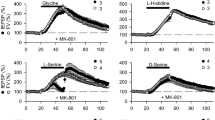Summary.
Taurine is an inhibitory amino acid acting as an osmoregulator and neuroromodulator in the brain, with neuroprotective properties. The ionotropic glutamate receptor agonist N-methyl-D-aspartate (NMDA) greatly potentiates taurine release from brain preparations in both normal and ischemic conditions, the effect being particularly marked in the developing hippocampus. We now characterized the regulation of NMDA-stimulated taurine release from hippocampal slices from adult (3-month-old) and developing (7-day-old) mouse using a superfusion system. The NMDA-stimulated taurine release was receptor-mediated in both adult and developing mouse hippocampus. In adults, only NO-generating compounds, sodium nitroprusside, S-nitroso-N-acetylpenicillamine and hydroxylamine reduced the release, as did also NO synthase inhibitors, 7-nitroindazole and nitroarginine, indicating that the release is mediated by the NO/cGMP pathway. On the other hand, the regulation of the NMDA-evoked taurine release proved to be somewhat complex in the immature hippocampus. It was not affected by the NOergic compounds, but enhanced by the protein kinase C activator 4β-phorbol 12-myristate 13-acetate and adenosine receptor A1 agonists, N6-cyclohexyladenosine and R(−)N6-(2-phenylisopropyl)adenosine in a receptor-mediated manner. The activation of both ionotropic 2-amino-3-hydroxy-5-methyl-4-isoxazolepropionate (AMPA) receptors and metabotropic glutamate group I receptors also enhanced the evoked release. The NMDA-receptor-stimulated taurine release could be a part of the neuroprotective properties of taurine, being important particularly under cell-damaging conditions in the developing hippocampus and hence preventing excitotoxicity.
Similar content being viewed by others
Author information
Authors and Affiliations
Additional information
Received February 7, 2002 Accepted March 6, 2002 Published online August 20, 2002
Acknowledgments The skillful technical assistance of Mrs Irma Rantamaa, Mrs Oili Pääkkönen, Mrs Sari Luokkala and the financial support of the Medical Research Fund of Tampere University Hospital are gratefully acknowledged.
Authors' address: Prof. Pirjo Saransaari, Brain Research Center, Medical School, FIN-33014 University of Tampere, Finland, Fax: +358 3 215 6170; E-mail: blpisa@uta.fi
Abbreviations: AIDA: RS-1-aminoindan-1,5-dicarbohydroxylate; AMPA: 2-amino-3-hydroxy-5-methyl-4-isoxazolepropionate; cGMP: 3′,5′-cyclic guanosine monophosphate; CHA: N6-cyclohexyladenosine; DCGIV:(2S,2R,3′R)-2-(2′,3′-dicarboxycyclopropyl)glycine; DHPG: (S)-3,5-dihydroxyphenylglycine; DPCPX: 8-cyclopentyl-1,3-dipropylxanthine; H-7: 1-(5-isoquinolinesulfonyl)-2-methylpiperazine dihydrochloride; HA: hydroxylamine; L-AP3: L(+)-2-amino-3-phosphonopropionate; L-AP4: L(+)-2-amino-4-phosphonobutyrate; L-NAME: NG-nitro-L-arginine methyl ester; L-NNA: NG-nitro-L-arginine; L-SOP: O-phospho-L-serine; NBQX: 2,3-dioxo-6-nitro-1,2,3,4-tetra-hydrobenzo[f]quinoxaline-7-sulfonamide; NBTI: S-(4-nitrobenzyl)-6-thioinosine; 7-NINA: 7-nitroindazole; NMDA: N-methyl-D-aspartate; PMA: 4β-phorbol 12-myristate 13-acetate; R-PIA: R(−)N6(2-phenylisopropyl)adenosine; SNAP: S-nitroso-N-acetylpenicillamine; SNP: sodium nitroprusside; trans-ACPD: (1±)-1-aminocyclopentane-trans-1,3-dicarboxylate.
Rights and permissions
About this article
Cite this article
Saransaari, P., Oja, S. Characterization of N-methyl-D-aspartate-evoked taurine release in the developing and adult mouse hippocampus. Amino Acids 24, 213–221 (2003). https://doi.org/10.1007/s00726-002-0310-z
Issue Date:
DOI: https://doi.org/10.1007/s00726-002-0310-z




